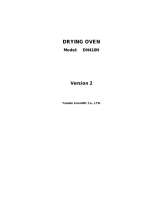
FP (E1.1) 03/2019 page 3/90
12.2
Proceeding overview ......................................................................................................................... 49
12.3 Proceeding in detail........................................................................................................................... 50
13. BEHAVIOR AT FAILURES .................................................................................. 56
13.1 Behavior after power failure .............................................................................................................. 56
13.2 Alarm messages ............................................................................................................................... 56
14. TEMPERATURE SAFETY DEVICES ................................................................... 56
14.1 Temperature safety device class 2 (DIN 12880) .............................................................................. 56
14.2 Temperature safety device class 3.1 (DIN 12880) (option) .............................................................. 57
15. OPTIONS .............................................................................................................. 59
15.1 APT-COM™ 4 Multi Management Software (option)........................................................................ 59
15.2 Data logger kit (option) ...................................................................................................................... 59
15.3 Additional measuring channel for digital object temperature indicator with flexible temperature
sensor Pt 100 (option) ....................................................................................................................... 59
15.4 Analog output for temperature (option) ............................................................................................. 60
15.5 Zero-voltage relay outputs via operation lines (option) ..................................................................... 60
15.6 HEPA fresh air filter (option) ............................................................................................................. 60
15.7 Mostly gas-tight version (option for FP 53 and FP 115) ................................................................... 61
15.8 Inert gas connection with mostly gas-tight version (option for FP 53 and FP 115) .......................... 61
16. MAINTENANCE, CLEANING, AND SERVICE .................................................... 63
16.1 Maintenance intervals, service .......................................................................................................... 63
16.2 Cleaning and decontamination ......................................................................................................... 64
16.2.1 Cleaning .................................................................................................................................. 64
16.2.2 Decontamination ..................................................................................................................... 65
16.3 Sending back the chamber to BINDER GmbH ................................................................................. 66
17. DISPOSAL............................................................................................................ 67
17.1 Disposal of the transport packing ..................................................................................................... 67
17.2 Decommissioning .............................................................................................................................. 67
17.3 Disposal of the chamber in the Federal Republic of Germany ......................................................... 68
17.4 Disposal of the chamber in the member states of the EC except for the Federal Republic of
Germany ........................................................................................................................................... 69
17.5 Disposal of the chamber in non-member states of the EC ............................................................... 70
18. TROUBLESHOOTING ......................................................................................... 71
19. TECHNICAL DESCRIPTION ................................................................................ 72
19.1 Factory calibration and adjustment ................................................................................................... 72
19.2 Over current protection ..................................................................................................................... 72
19.3 Definition of usable space ................................................................................................................. 72
19.4 Technical data ................................................................................................................................... 73
19.5 Equipment and options (extract) ....................................................................................................... 75
19.6 Accessories and spare parts (extract) .............................................................................................. 76
19.7 Dimensions FP 53 ............................................................................................................................. 77
19.8 Dimensions FP 115 ........................................................................................................................... 78
19.9 Dimensions FP 240 ........................................................................................................................... 79
19.10 Dimensions FP 400 ........................................................................................................................... 80
19.11 Dimensions FP 720 ........................................................................................................................... 81
20. EU DECLARATION OF CONFORMITY ............................................................... 82
21. PRODUCT REGISTRATION ................................................................................ 84
22. CONTAMINATION CLEARANCE CERTIFICATE ............................................... 85
22.1 For chambers located outside USA and Canada ............................................................................. 85
22.2 For chambers in USA and Canada ................................................................................................... 88

























